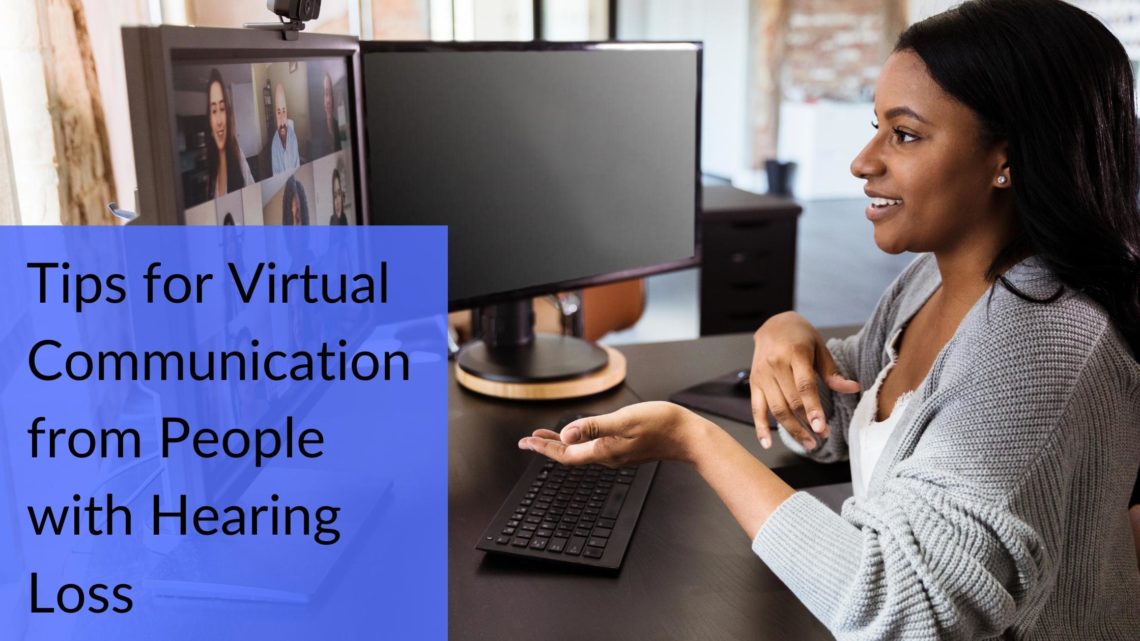We are entering our third year living amongst a global pandemic that inhibits our ability to connect with people in person. Between surges of new strains of COVID-19, we can spend time close to people out of our quarantine bubble but because of the fluctuations in restrictions, many people have normalized working, attending doctors’ appointments, school, and social events from the comfort of home. With 2020 at the start of the pandemic came the realization that meeting virtually is a viable option, which can save resources such as time, a commute, and the need for large spaces to accommodate many people. It’s likely that even if COVID-19 retreats many of us will continue to work from home.
However, for people with hearing loss, virtual meetings create particular barriers that those with normal hearing rarely consider. While these technological assets gave us new ways to connect, they also brought with them a range of challenges such as “Zoom fatigue”. Communicating virtually all day can be exhausting for anyone, but those with hearing issues have added hurdles such as distorted digital sound and the loss of important visual cues. With the disadvantages come significant enhancements as well, not available for in-person meetings. Here are some tips for communicating successfully for virtual communication.
Pause and Breath
It often makes people anxious when there is silence or pauses in conversation. However, hearing-impaired people can gain a lot from slow and gaited speech. Pausing at the end of sentences and concepts gives hearing-impaired people a chance to fully absorb what has been said. It takes a lot more energy to hear when you have a hearing loss. Parts of words or words in sentences are lost depending on the severity of the hearing loss, requiring more concentration and cognitive resources to listen and respond. In digital spaces, don’t be afraid to let longer pauses into the conversation. Even those without hearing loss can benefit from taking these breaks in a digital space where sound can be distorted, or poor bandwidth may delay the delivery of audio.
Real-time Talk to Text
Virtual communication allows for enhancements to allow you to be able to follow conversation in a way that would be difficult in person. For instance, many video conferencing sites such as Google Meet have real-time talk to text, which provides captioning as people speak. This technology can aid in reading what was missed in the audio field, due to a hearing impairment, however, it has a lot of room for improvement. Captioning can often be confusing or comical at times due to incorrect translation.
Highlight the Speaker
It can be overwhelming to know who is even speaking on many video conference calls, with many boxes and a person in each. To combat this many video conference apps, have settings to allow you to highlight the speaker. When the person speaks it features them, allowing you to rely on lip-reading and visual cues to hear better.
Headphones and Bluetooth Connectivity
The speakers on many laptops can be difficult to hear clearly, even with normal hearing. Those with a hearing impairment may enjoy using headphones to ensure clear sound which is free from ambient distractions in your workspace. This can make it easier to hear over the sounds of your neighbors through the apartment wall, traffic outside your window, or even your kids shouting in the room over. Thanks to Bluetooth connectivity features on many hearing aids, you can now send the audio signal from your personal computer or smartphone directly to your hearing aids.
Noise Canceling Headphones
Many enjoy noise-canceling headphones which cancel out distracting background sounds by sending out an inverted soundwave. The results allow you to hear your meeting through your headphones without the temptation to turn up the sound too dangerous decibels, which could damage your hearing worse.
Treat Your Hearing Loss
Are you having trouble following along with your virtual meetings? It could be a hearing loss and you don’t even know it. It’s a good idea to have your hearing checked annually to detect a hearing loss before it can escalate into a bigger issue. Hearing aids can make virtual communication significantly easier. To find out more about what hearing technology can offer, schedule an appointment with us today.

